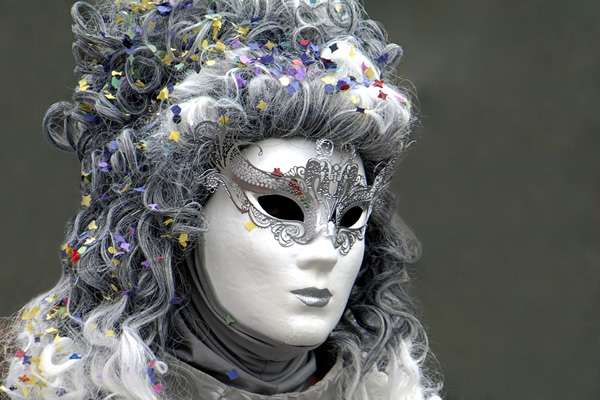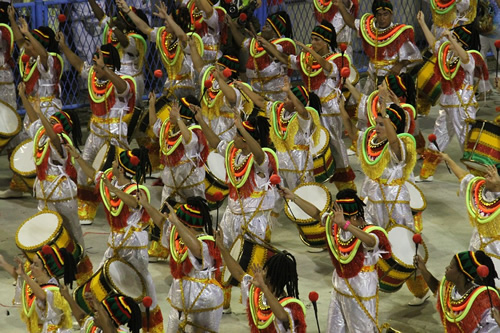Travel Photography Tips: Festivals and Cultural Events
By Volker Poelzl
 |
| Mask at the Carnival in Venice. |
Festivals and cultural events are among the most exciting events for travelers to photograph. They are a great way to learn about the local culture, customs and people and portray a foreign culture and country with lively photographs. Photographers are naturally drawn to colorful subject matter, and festivals are just that: colorful in every sense of the word. There are colorful floats, costumes, crafts, food, and merchandise, and you will also find many colorful characters among the participants. But because festivals consist of moving performers or participants and large crowds of spectators, they are also among the most difficult subject matter to photograph. In most cases you only have a fraction of a second to chose an interesting subject, focus your camera, choose your zoom setting, and press the shutter. To make the most of your festival experience as a photographer, you need to be ready to make quick decisions about when and what to photograph. A little preparation ahead of time will go a long way to help you take great pictures.
Choosing the Right Festival
On my travels I have often accidentally come across local festivals, but it is a good idea to plan ahead and do some research to find out which are going on at the time of your trip. Ask yourself what type of festival or cultural event interests you the most. Do you like large events with thousands of participants and millions of spectators, or small local festivals, which have a more relaxed atmosphere and offer a more intimate view of local life and culture? Do you enjoy religious festivals or celebrations of local cultural traditions? Some take place only on one day, while others last days or even weeks. Brazil’s carnival festivities are so large and crowded that I took advantage of the smaller and more intimate parades and events that took place during the two weeks leading up to Mardi Gras. The crowds were smaller, and I had a much better time taking pictures than during the main events that attract millions of revelers.
 |
| Dancers and moving performers, such as during the Carnival in Rio, Brazil, are difficult to photograph. |
Learn About the Festivals
If you want to take pictures that effectively portray a festival, you should find out beforehand what the festival celebrates or commemorates and what it means. Is it a religious festival dedicated to a patron saint? Then you should make sure to take pictures of the procession’s most important floats, which will feature the patron saint. If you are attending a cultural festival that shows different aspects of local culture such as handicrafts, music, art, and dance, then make sure that your pictures reflect the diversity of cultural activities. During my India trip I visited Kolkata during the large Durga Puja festival, a celebration dedicated to the Hindu goddess Durga and her victory over a demon. I was fortunate that my Indian friends explained the symbolism of the festival to me beforehand. When I attended the different events all over the city, I already knew about the most important elements of the festival and I was able to successfully document them with my camera. If you are attending a parade or procession, it can be a great advantage to find out the route of a parade or the program of an event in advance. This allows you to plan ahead and choose a good position from which to take pictures.
Finding an Observation Point
One of the challenges of taking pictures of festivals is to position yourself in such a way that you have enough space around you to select your subject matter while being close to the action. To take good pictures of crowded events it is important to step back to get a better view of the event. I usually try to find a doorway or stand against a wall to make sure that my back is covered, but I also try to find a good vantage point (such as a low wall, bench, or fountain), where I am slightly above the crowd and have a better view of the ongoing activities. This allows you to stay in one position and take pictures as the parade or processions moves past you.
Sometimes the street layout does not allow for a vantage point from which to observe and photograph the activities. In this case you must go where the action is and immerse yourself in the crowd. You will be competing with revelers and other photographers for the best position. Have your camera ready to shoot and be prepared to take pictures quickly, since people are moving and won’t hold their positions for long. Many digital cameras have a continuous shooting mode, which allows you take several shots per second. This is a great feature to photograph moving objects. You could also use your camera’s movie function and extract single shots later on. However, the quality of a single movie frame is never as good as a still shot.
Choose a Variety of Subject Matters
To document a festival it is important to focus on detail and individual participants. This is the main challenge of taking photos of festivals: to tell the story of the people who participate in it and not just show pictures of crowds. Pictures of reveling masses do not really tell a story and rarely make great photos. If you decide to show a large crowd, make sure there is a central object of interest, such as a float or group of participants that stands out. Otherwise your pictures will just show a confusing mass of people without any focus or point of interest. Instead of general wide-angle shots, try to take pictures that are characteristic of the festival and at the same time show interesting people. I usually try to document the broad spectrum of activities and participants in a festival. There may be floats that are carried or driven, dancers, musicians, and a variety of vendors in addition to the audience. Try taking a few pictures of all these different people to create a lively and authentic portrayal of the festival. When I took pictures at a religious festival in northern Portugal, I took pictures of children dressed up in costumes, musicians, floats with the images of saints, as well as activities at the periphery of the event, such as outdoor BBQs and vendors of religious knickknacks.
Lighting Conditions
Unfortunately photographers cannot choose the time of day a festival takes place. If you take pictures mid-day you may end up with washed out colors and overexposed highlights. In the late afternoon the light is warm and your pictures will have an orange tint. Is the sun low in the horizon? Then buildings will soon cast a long shadow on the festival activities, which will affect your photographs. When I took pictures during a mid-day carnival parade in Brazil, I only realized later that my camera settings were wrong. Salvador, a city in northeastern Brazil is the center of Afro-Brazilian culture, and all the participants of the parade were black. In the bright light of the tropics, the automatic exposure setting on my camera did not do justice to the dark faces of the parade members. I ended up with a lot of interesting pictures of musicians and dancers, but their faces were often dark and without detail.
So before you indulge in the revelry during a parade or festival, do a quick check of the weather and lighting conditions to make sure your photographs turn out as desired. If you take a picture of festival activities against a bright background, consider using your flash to brighten up the foreground. A powerful external flash will also help you light up dark scenes. You can increase the ASA setting on your camera, but you will end up with a lot of noise on your photos. Keep in mind that the built-in flash on most cameras is only intended to brighten objects that are reasonably close. If you want to take pictures at a greater distance, you should get an external flash. Also keep in mind that when using a flash, the shutter speed on most cameras is automatically set to 1/60 of a second, which is too slow to capture moving objects or people. Also keep in mind that your camera’s auto-focus may not work well after dark, since it depends on contrast to measure distance.
Safety Concerns
Large festivals with large crowds also attract pickpockets and thieves. Pay careful attention to your surroundings while taking pictures. Since there is constant action during a festival, there is no time to put the camera in your bag between taking pictures, and you will most likely carry it around your neck during the course of the event.
Camera Equipment
Since most festivals and cultural events take place in public spaces right before your eyes, you do not really need a powerful telephoto lens. In fact, since there is a lot of movement during a festival, it is better to use a wide-angle zoom lens, which is usually faster and allows you to shoot with a higher shutter speed. The built-in zoom lenses in pocket and compact cameras should be sufficient to take great shots during a festival. The automatic exposure function on most cameras will choose an average setting of aperture and shutter speed, but since you will be photographing moving people, you should choose a manual setting with a higher shutter speed. This assures that your pictures of moving people are not blurry. Some cameras have automatic exposure presets, such as “portrait,” “landscape,” or “sports,” which makes it easy to choose a setting that is suitable for the event.
All digital SLRs and many compact digital cameras give you the option of saving photos in RAW format. This is an unprocessed image format that gives you greater freedom to adjust the image on your computer later. For example, when shooting in RAW format you could significantly brighten a dark image by changing its exposure value later. Although this method is not a substitute for ideal lighting conditions, it gives you greater control over the image, and you might be able to turn dark or overexposed photos into attractive pictures. The only drawback is that the RAW files are much larger than JPEG files (the most common format used by digital cameras). To avoid running out of memory, you should bring several memory cards and use cards with the highest memory capacity your camera can read.
Volker Poelzl is a contributor and columnist for Transitions Abroad. On his extensive travels in over thirty countries worldwide he has photographed dozens of festivals.
|
